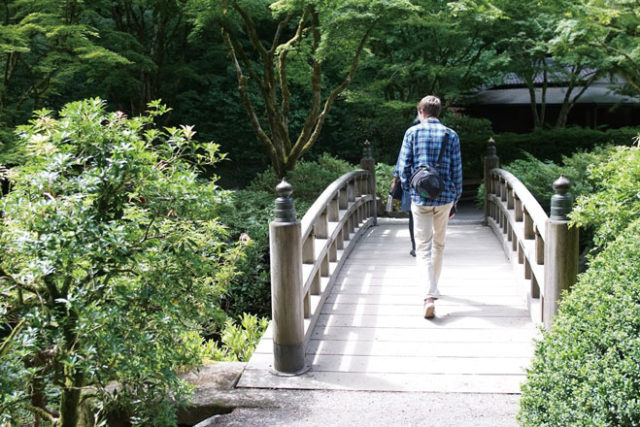By Nicholas Turner
For The North American Post
I’ve said in previous articles that I don’t feel I belong in this country, nor do I feel I belong in Japan, even though my mother was born there. Certain things remind of this awkward position in that I am at once a resident at home and a tourist abroad, using what I know to navigate the new. When my family goes out for sushi in downtown Portland or when I watch a Japanese drama with my mom after dinner or when I use chopsticks to eat french-fries; these circumstances force me to reposition myself in what I consider a globalized world. In other words, they make me feel exactly what I am: a hapa kid.
I had the same feeling over the weekend when I visited the Portland Japanese Garden. I had been meaning to go for years but for some reason never did. The sun was high in the sky and a light breeze kept things cool, so I asked my mom if she would like to go with me. My friend Sean joined us and we got there around noon. The garden itself is small; it took the three of us all but half an hour to walk the entire thing. But what it lacks in size, the garden compensates with a thoughtful display of botany, architecture, and natural life. Let me try to paint it for you: an intricate system of trails dotted with smooth stepping stones weaves through the garden like a river travelling down a mountain. As you walk these trails you see ponds fed by rushing waterfalls, wooden bridges crossing over creeks filled with red, gold and white koi fish and zen gardens with ripples travelling through white gravel and wrapping around rocks covered in vibrant green moss.
On a brochure it says that former Ambassador Nobuo Matsunaga once visited the Portland Japanese Garden and said it was “the most beautiful and authentic Japanese garden in the world outside of Japan.” Despite my limited experience with gardens, I’m inclined to agree with him.
The garden was designed by a professor named Takuma Tono in 1963. It spans 5.5 acres with five separate but connected smaller gardens, each with a different style of their own. Visitors can walk by the authentic tea house, follow the meandering streams, or enjoy a clear view of Mount Hood; there are many things to do in the garden.
And soon it will expand. With the help of renowned architect Kengo Kuma, who was entrusted with the design of the National Stadium for the 2020 Tokyo Olympics among other significant cultural sites around the globe, garden curator Sadafumi Uchiyama will lead the design and creation of new garden spaces and educational facilities for the Cultural Crossing Campaign, a project designed to help the garden accommodate more visitors and safeguard the preservation of Japanese garden arts and culture around the world. The expansion will include three new LEED certified buildings, including a “Village House” with classrooms, galleries, and a café, along with seven garden spaces with public water features and a bonsai terrace. The project will cost $33.5 million, all of which has come from donations and grants. The expanded garden will open in Spring 2017.
This project marks a positive shift in the relationship between Japan and the United States. Though it might feel like a tourist attraction for some, the garden is a necessary connection between the two countries. For people like me, it evokes nostalgia and serves as a reminder of the purity and elegance that defines Japanese culture. For others, like those who have only hearsay, it sparks curiosity and admiration and gives them a taste of its culture. Even my friend Sean, an American, said he was curious to see if gardens really looked like this in Japan. He kept saying silly things like, “Japan seems pretty cool” or “Why aren’t American gardens this pretty?” I gave him vague answers and laughed at him jokingly. I told him he should visit the country someday. I know he would enjoy it.









